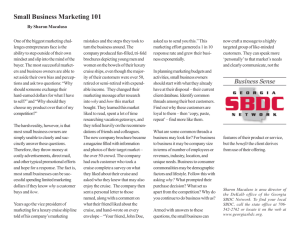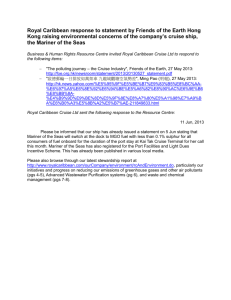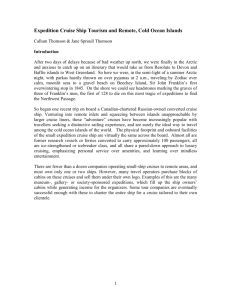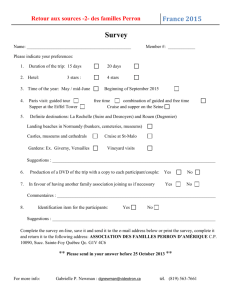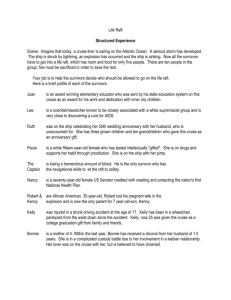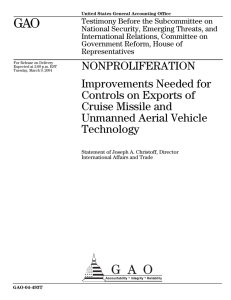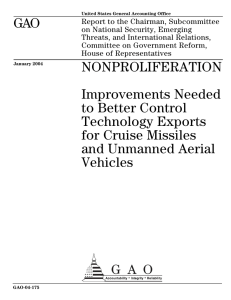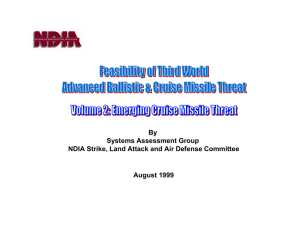Outline
advertisement
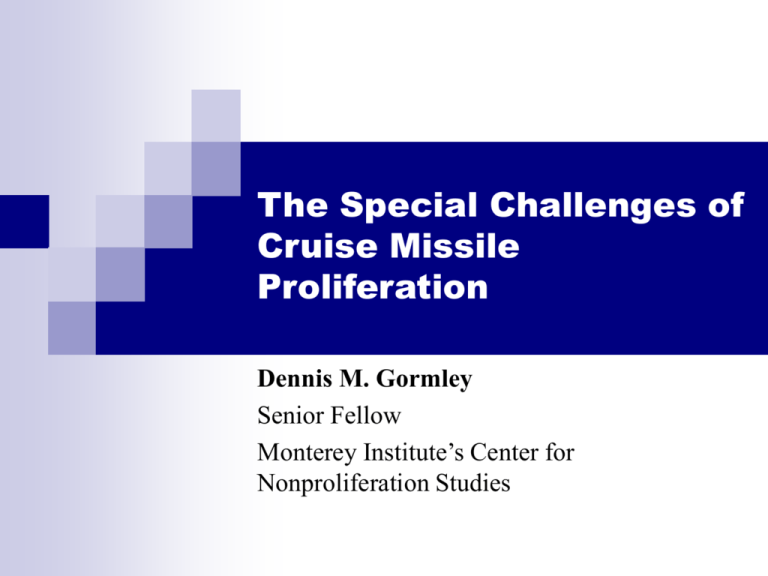
The Special Challenges of Cruise Missile Proliferation Dennis M. Gormley Senior Fellow Monterey Institute’s Center for Nonproliferation Studies Definition: Cruise Missile A cruise missile is essentially a small unmanned aircraft designed for offensive missions Like an airplane it generates lift by airflow over aerodynamic surfaces and is propelled by a small jet engine The focus of this discussion will be on cruise missiles for land attack and unmanned air vehicles capable of being turned into weapons-carrying cruise missiles However, many jet-propelled anti-ship cruise missiles have essentially the same design, and while they are optimized for attacking ships at sea, they potentially could be converted to land-attack roles The Context Obsessive focus on ballistic-missile proliferation as cruise-missile use increases Cruise missile proliferation seen as “lesser included case” National Intelligence Estimates emphasize that “other means,” including cruise missiles, are more likely ways of attacking the US homeland Quantum leap in enabling technologies for land-attack cruise missiles (LACMs) Slow but steady increase in LACM manufacturers Strategic consequences for viable force projection and possible threats to homeland Slowly reacting defense preparedness and serious loopholes in nonproliferation policy Key Points Threat uncertainty has led to either careless exaggeration or— more the case—neglect and an excessively singular focus on the ballistic-missile threat Multiple paths to cruise-missile acquisition, pace of technological change, and weak export controls, mean that the cruise-missile threat could emerge suddenly—before minimal defense preparedness measures are in place Unfolding threat demands hedging strategies encompassing both improved non-proliferation policy and investments in technology readiness programs Technological change challenges governments to keep nonproliferation policy up to date Outline Technological challenges of acquiring LACMs Alternative ways to acquire LACMs Defending against LACMs Strengthening non-proliferation policy Technological Challenges of Acquiring LACMs Key enabling technology—from TERCOM and DSMAC to GPS/INS Small aerospace firms now provide variable autonomy flight management systems Commercial satellite imagery for fixed targets and GPS-aided mission planning Advanced propulsion systems for >1000 kilometer ranges still remain tightly held But propulsion workarounds abound: civil systems, reciprocating engines Knowledge and Skill Requirements Aeronautical, electrical, computer, mechanical/machining, and testing skills Systems-integration skills needed for complex weapon-system development Two primary drivers: scope and sophistication of indigenous skills and level and quality of foreign assistance True autarky is mythical Alternative Ways to Acquire LACMs Converting anti-ship cruise missiles (ASCMs) into LACMs Converting unarmed UAVs into LACMs Converting very light manned aircraft into armed UAVs (viz., LACMs) Acquiring LACMs from industrial suppliers Converting ASCMs From pool of ~75,000 ASCMs, potential conversion candidates are likely to be a small fraction Modern designs offer little space (physical volume) for longer-range conversions (additional fuel) Silkworm-class ASCMs offer attractive potential Developing modern land-attack navigation system is biggest barrier; finding suitable propulsion is next Several years to achieve full capability to manufacture and effectively deploy converted ASCMs (cut in half with substantial foreign assistance) Notional Extended-Range HY-4 Role: Land attack Cruise Altitude: 100 to 200 m Length: 8.48 m Maximum Speed: 0.68 (Mach) Body Diameter: 0.76 m Launchers: Ship, truck/trailer, aircraft Wingspan: 2.41 m Modifications: Launch Weight: 2,221 kg • Installation of Land-Attack Navigation System Range: 708 km • Installation of fuel “plugs” Warhead: 500 kg HE • Fuel system modifications Guidance: GPS-IMU Propulsion: Turbojet Fuel: 855 kg Hypothetical Tularemia Attack on San Diego A land-attack Silkworm variant, moving southward offshore, releases 120 kg of liquid BW agent. The colored bands represent the probability of infection (yellow >90 percent, green >50 percent, pink >10 percent). Converting Unarmed UAVs Major market growth expected in both military and civilian sectors by 2005 40 nations produce UAVs, of which half are not MTCR members Some already come with GPS/INS systems Several examples (India, South Africa, Israel, Italy) already demonstrate conversion potential True range potential of UAVs not apparent—recent study reveals that nearly 80 percent of 600 UAVs examined have ranges >300km >75% of the UAVs Have Range Greater Than 300 km 16,000 >2000 km 16% 14,000 <300 km 21% 12,000 1001-2000 km 20% Range (km) 10,000 301-500 km 14% 8,000 501-1000 km 29% 6,000 4,000 2,000 0 0 100 200 300 UAVs 400 500 600 Converting Very Light Aircraft Appeal represented by low cost, ease of conversion, and challenges posed to advanced air defenses Many well-tested designs with ranges to 1000km, payloads of 150kg, take-off distances of 100-200m, cruise speeds of 120kts (stall speeds <80kts) UAV flight control systems—permitting conversion from manned to unmanned flight—make conversion much easier “Poor man’s” strategic arsenal or terrorist’s weapon of choice? Quest for WMD Interest in aerial balloon delivery for dispersing biological or chemical agents Crop duster airplanes investigated by at least two of the September 11 plotters 43 recorded cases involving 14 terrorist groups in which remote-control delivery systems either threatened, developed, or actually utilized Aerodynamic delivery (airplanes, UAVs, cruise missiles) most effective method of delivering biological and chemical agents Suicide appeal is compelling but effectiveness probably drives choice of delivery means Simply Buying LACMs Expanding number of LACM producers with strong export motivations to reduce unit costs European manufacturers have leapt to top rung of world producers Russia and China could choose to exploit MCTR deficiencies regarding cruise missiles Marketing Brochure for Russia’s Kh-65SE Cruise Missile Defense Challenges Detecting another class of air targets featuring Reduced signatures Terrain masking Use of simple endgame countermeasures 360 degree route of attack Need for high clutter rejection Saturation attacks with cheap UAVs Fratricide or identifying friend from foe (IFF) problems The Limits of Defense Preparedness Despite huge investments in air defenses, notable shortcomings—some on display during Operation Iraqi Freedom—exist in defending against LACMs Limited connectivity among services in C3 and combat ID Each service procures equipment and develops procedures unique to its own vision of LACM defense Only a handful of manned interceptors supported by limited ground-based radars comprise continental air defenses Virtually no detection capability below 3000 feet over the US homeland “Poor man’s” arsenal of low-cost cruise missiles threatens to make both ballistic- and cruise-missile defenses problematical Yet, however difficult the challenge, there is something to build upon, which is less the case with ballistic missile defense The Effect of RCS Reduction on AWACS Performance (Target Speed: 800 km/hr) •7 square meter aircraft •0.1 square meter cruise missile •0.0001 square meter cruise missile •Detection range: 370 km •Detection range: 130 km •Detection range: < 25 km •Reaction time: 28 minutes •Reaction time: 10 minutes •Reaction time: < 2 minutes Implementing Joint Cruise Missile Defenses Congressional support began in earnest with “Cruise Missile Defense Initiative” FY96 Defense Authorization Act Very uneven technology development program thus far—Air Force only service making some progress Several years of technology development needed to position DOD to implement Defense Planning Guidance on CMD Homeland defense requires both external and internal focus Cruise missile defense remains weak sister to BMD programs Four LACM Defense Priorities 1. 2. 3. 4. Providing a single integrated air picture with greatly improved combat ID Improving the performance of airborne surveillance radars and missile seekers against low cross-section cruise missiles and linking elevated sensors to ground- and air-based shooters to create a widearea defense Lowering the cost of air-defense interceptors to cope with large, lowcost raids of LACMs Exploiting improvements in theater cruise missile defense to consider homeland defense options Nonproliferation Policy Options 1987 Missile Technology Control Regime Seeks member adherence to agreed list of export-policy guidelines controlling transfer of ballistic, cruise, UAVs having range of 300km and payload of 500kg (nuclear) 1993 modification to include systems capable of delivering chemical/biological payloads Wide range of dual-use technologies subjected to caseby-case review Members—now 33—unilaterally implement export controls MTCR Successes: The Glass Half Full Dismantling of the Condor ballistic missile program Hundreds of blocked transfers of components, technologies, and production capabilities Strong consensus on ballistic missile transfers Need to capitalize on recent MTCR attention to UAVs/cruise missiles Antiterrorism Proposal MTCR Warsaw Plenary 2002: examine ways of limiting the risk that controlled items and their technologies could fall into the hands of terrorist groups Terrorist capabilities trail ambitions: therefore make the “long pole in the tent” (flight management) even longer U.S. “anti-terrorism” proposal to Wassenaar Arrangement reflects concern about kit airplanes as terrorist weapons, but it failed to elicit support because of lack of specificity Changes to the MTCR technology annex (Item 10) covering flight controls are needed to impose case-by-case reviews of UAV flight management system Advantage over Wassenaar because of MTCR’s no-undercut provisions Strengthening Non-proliferation Policy: Top Priorities 1. 2. 3. 4. 5. Creating a uniform set of ground rules for determining LACM/UAV range and payload--Accomplished Close existing loophole on flight management systems--Attempted in Wassenaar Agreement (needs reformulation and consideration in MTCR, too) Implementing tighter controls on stealthy cruise missiles--Attempted but stalled by lack of consensus Implementing tighter controls on countermeasure technologies specially designed for LACM penetration Broadening current MTCR parameters governing controls on jet engines--Accomplished
